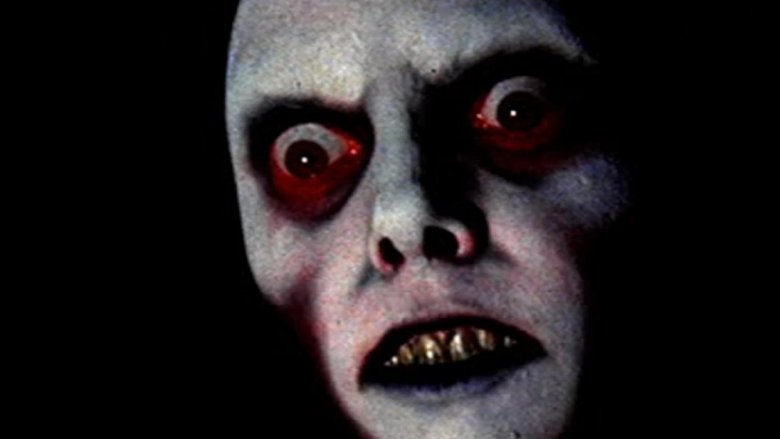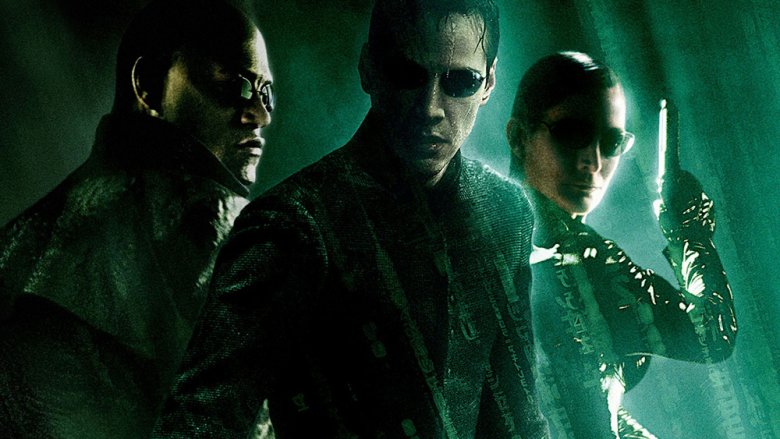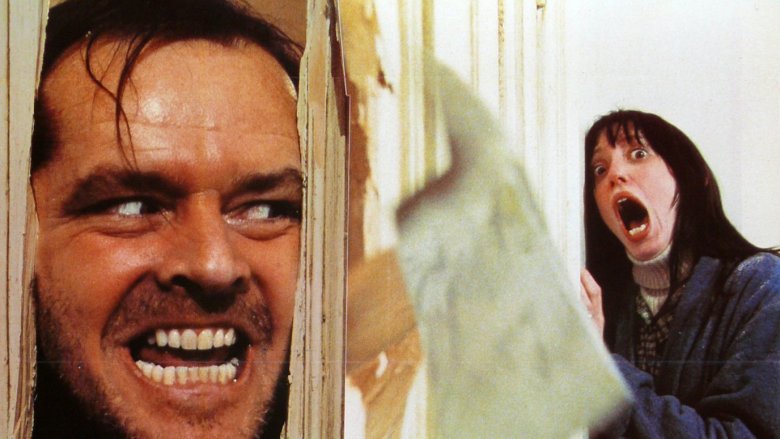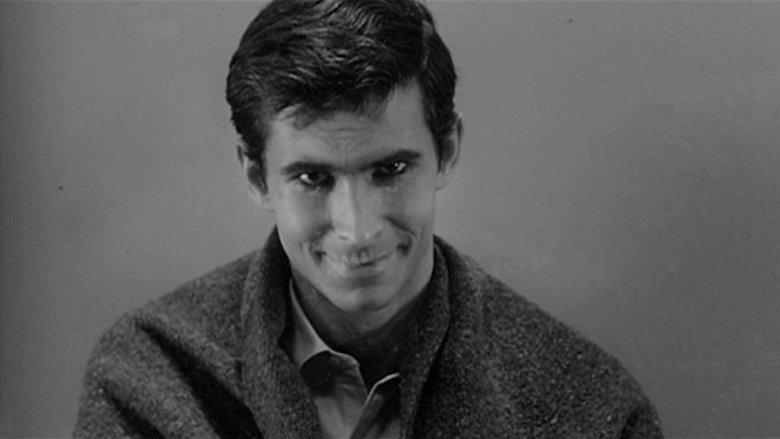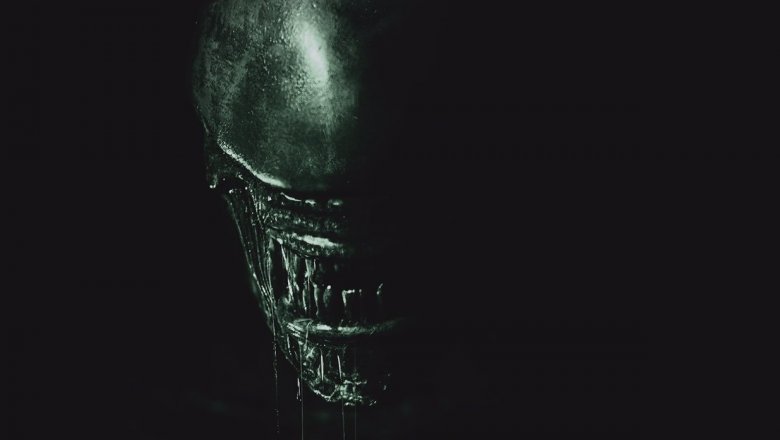Bizarre Subliminal Messages Buried In Movies
We value our minds, and we like to think that we control them. Maybe that's what makes subliminal messages so creepy: the notion that someone or something has sneaked into our heads without us consciously realizing it, whether it's through a hidden subtext or a split second of film footage. It's enough to make even the toughest customer curl up in the blankets and snuggle with a teddy bear.
The art of subliminal messaging has been tied to film since the infamous 1957 stunt where market researcher supposedly spliced "Drink Coca Cola" messages into a film, which was later revealed to be a hoax. However, subliminal messages still have a way of nudging their creepy, wormy little fingers into us, particularly when they're inserted into seemingly innocuous movies. Here are some of the more bizarre instances of subliminal messages that have been secretly buried into your favorite movies. Get a stiff drink ready, because we're in for some spooky stuff. Also be warned — big spoilers ahead.
Fight Club
This is a goldmine. Seriously, seeing Fight Club for the first time is like being a little kid again and jumping into a ball pit, except this time, all the innocent little plastic balls are actually made of solid steel and covered in invisible razor blades. This mind-bending meditation on toxic masculinity loves subliminal messages so much that subliminals actually figure into the plot: when Tyler Durden (Brad Pitt) gets a job as a projectionist, he tells the Narrator (Edward Norton) about how he splices in a single frame of porn — into a children's movie, no less — just to make the audience feel unsettled without knowing why.
So yeah, that Tyler Durden guy is one messed up dude. Except he's not real. Fight Club's subliminal masterstroke, which only becomes apparent on subsequent viewings, is that it foreshadows the movie's big twist way ahead of time.
See, Tyler Durden is actually the Narrator's alter ego, but the Narrator himself is so loopy he hallucinates Tyler as a separate person. Well before the Narrator officially "meets" Tyler, Brad Pitt actually blinks onto the screen on multiple occasions. Tyler blinks into one of the Narrator's testicular cancer meetings. He blinks into the doctor's office. He appears on a TV commercial. It's almost as if Tyler is trying to bust into the Narrator's subconscious — and ours — and hasn't quite cracked it yet. It's like our worst nightmare brought to life.
The Matrix Reloaded
Next time someone gives a holy lecture about how blasphemous popular entertainment is, it's worth mentioning that The Matrix Reloaded is loaded with religious allegories. Actually, the whole trilogy is so biblical in scope and themes that it could probably part the Red Sea. Maybe.
How so? Well, aside from the obvious Christ allegory going on with Neo being "the One," there are subliminal messages slipped into the film straight from the Bible. The most interesting of these is the film's use of license plates, loading those seemingly insignificant chains of numbers and letters with all kinds of holy context. The trilogy's main villain, Agent Smith, has a license plate that reads IS 5416. This is a reference to Isaiah 54:16. And hey, before anyone thinks this is a coincidence, sneak a peek at the passage there: "See, it is I who created the blacksmith who fans the coals into flame and forges a weapon fit for its work. And it is I who have created the destroyer to wreak havoc."
However, the biblical license plates don't end there. The character of Trinity — notice her name, by the way — also has subliminal messaging in her license plate, which reads DA203. This is Daniel 2:3, and the passage there is, "And the king said unto them, I have dreamed a dream, and my spirit was troubled to know the dream."
Huh. Yeah, that pretty much sums up the entirety of The Matrix trilogy.
The Shining
Stanley Kubrick was the kind of dude who was so attentive to detail — or so anal about it, some might say — that he probably had his car's serial numbers memorized by heart. Lest you think we're exaggerating, consider that when he directed Dr. Strangelove, Kubrick made sure that the sets depicting the inside of the B-52 bomber were 100 percent accurate, despite the fact that actually seeing the inside of B-52 was, at the time, totally classified.
The point is, Kubrick didn't make mistakes. So it's certainly an intentional decision on his part that the interior layout of the Overlook Hotel, the haunted house in The Shining, is absolutely physically impossible.
For context, let's remember that The Shining's plot entails a recovering alcoholic named Jack Torrance bringing his family into the Overlook: to kindly return Jack's favor, the hotel then turns him into a murderous psychopath. To depict Jack's slide into insanity, Kubrick deliberately skewed physical perceptions by having the Overlook's layout make no sense whatsoever. The specific geographic impossibilities have been mapped out by dedicated fans, who've pointed out windows that shouldn't exist, overlapping rooms, illogical walls, and so on. These bizarre, almost imperceptible distortions create a subtle cognitive collision within the viewer.
Who figured this out? It had supposedly been talked about for a while but was highlighted when someone making a custom map of the Overlook Hotel for Duke Nukem 3D found that it violated the laws of physics.
Memento
Back before Christopher Nolan was reinventing the superhero genre or crafting World War II blockbusters, he was known for slick and quiet psychological thrillers, the most prominent among them being Memento. This film, starring Guy Pearce as Leonard, tells its story backward — starting at the conclusion of the film, and moving slowly to the beginning — in order to capture Leonard's anterograde amnesia, which causes him to lose all his memories every few minutes.
The movie's plot shows Leonard tracking down John G., the man who raped and killed his wife, a goal he only remembers because he's tattooed it onto his body. During this process, Leonard tells the story of a fellow retrograde amnesiac, Sammy Jankins, whose condition caused him to accidentally kill his diabetic wife by administering too much insulin, over and over again.
Spoiler: Leonard is actually the one who killed his wife by insulin overdose. His guilt has caused him to repress the memory, so he keeps hunting for a "John G" and has transposed his story onto Sammy.
This is a major twist at the end of the film, but Nolan actually uses subliminal messaging to clue the audience in way ahead of time. At one point, while Leonard is telling "Sammy's" story, Sammy's image is replaced by Leonard for a split second. This single-frame splice is so brief that most audience members miss it, but it's a heavy hint that Leonard's story isn't really about Sammy.
Beauty and the Beast
No, not Disney! How could the House of Mouse do this to us? Sure, we knew Tyler Durden was happy to screw with us, but Disney? Yes, digging into the history of subliminal imagery reveals that even the animated classics we grew up on were busy messing with our heads.
One Disney movie that was especially gleeful about sneaking subliminal imagery into our poor little brains was 1991's Beauty and the Beast. Ever wonder why Belle seems like such an outsider in her poor little village? It's not just that she reads books. All of the other villagers are wearing washed-out earth tones, the same color scheme as the village itself, while Belle is the only one wearing blue. This color clash is why she seems so "different." Disney, you sly devils!
But the sneakiest bit of subliminal imagery tucked into the movie comes into play during the death of that arrogant villain, Gaston. The animators wanted to show that the egotistical jerk was dead, dead, dead, but displaying his rotting corpse impaled on the spikes beneath the castle would set off alarm bells around the studio. So instead, they literally drew the reflection of skulls over his pupils, which appear for only a single frame. Gaston's been in the grave ever since, so by now he's certainly irritating everyone in the afterlife with his haughty shows of manliness.
Psycho
Back in 1959, everyone thought cheap motels were a good deal and that showers were the safest places in the world. But then Alfred Hitchcock came along in 1960 and ruined it, making the world afraid of cheap motels and frightening millions of people into always locking the bathroom door when they shower.
Psycho, as we all know today, is the story of a boy's close, loving relationship with his overprotective mother ... except the mother has been a mummified corpse for ten years, and the boy is a psychotic man named Norman Bates. Whenever Norman becomes attracted to a nice young woman, his "Mother" personality goes out and kills her.
This rather uncomfortable twist, which was loosely inspired by real-life serial killer Ed Gein, comes in at the end of the film. Norman is taken into custody for his murders, and the camera lingers on his face as the Mother personality takes over his mind, demonstrated by a voiceover in which "she" claims that the murders weren't her fault. It's a suitably creepy ending for a creepy movie.
But it's injected with a little extra tingle of creepiness when, for two seconds of film, Hitchcock overlays the image of Mother's rotting skull over Norman's face. This brief subliminal effect, a visual representation of the dark reality inside Norman's mind, will leave puffy, throbbing scars on your mind for a long, long time.
Total Recall
No, not the 2012 remake. We're talking about the surreal, dreamlike, highly underrated Arnold Schwarzenegger vehicle from 1990, directed by Paul Verhoeven. When this movie isn't segmenting Arnold's face or bulging his eyes out of his skull, it get its kicks by destroying your sanity.
Throughout the movie's duration, it's deliberately unclear whether the rather bizarre experiences occurring are real or if they're a vivid dream that Arnold's character, Quaid, had injected into him by the Rekall corporation. At one point, another character even tells Quaid that he's fallen too far into the dream, and if he doesn't wake up, he'll get lobotomized.
By the way, Quaid shoots this guy. Oops. By the film's conclusion he's made it to Mars, gotten the girl, and managed to spread an Earthly blue sky across the Red Planet in a few minutes. Wow, blue sky on Mars, huh? That's cool.
Except right at the beginning, the film drops a subliminal cue that tells you exactly what's going to happen while you're too distracted to pay attention. When Quaid is first getting set up at Rekall, a background technician named Ernie casually comments about Quaid's program, stating, "That's a new one, blue sky on Mars!" So yeah, Quaid probably got lobotomized. According to Verhoeven, Quaid "likes the dream so much he does not want to wake up." Viewers would have been stuck right there with him if it weren't for that smarmy little Ernie guy.
Cloverfield
Just when years of cheesy Mighty Morphin Power Rangers reruns had managed to convince us that giant monsters were safe and cuddly creatures that always got blasted by Megazords, the team of Drew Goddard, J.J. Abrams, and Matt Reeves decided to rip off the Statue of Liberty's head and throw it into New York's streets. Thanks, guys. We really appreciate those swell new nightmares.
The cleverness of Cloverfield is actually in what it doesn't show, rather than what it does. It's a film that knows how to use the found-footage format to pack a serious punch, putting the viewer in NYC's streets as a giant purple monster ruins everybody's day. Because the viewer doesn't get access to any White House meetings or top-secret calls, no one has any idea where this freaky purple giant even came from. However, some sharp-eyed eagles believe that in the background of one scene, you can just barely see something weird dropping from the sky and falling into the ocean.
But the subliminal content doesn't end there. As a tribute to the giant monster movies that inspired Cloverfield, the film splices in microseconds of frames from the '50s giant ant movie Them!, as well as The Beast from 20,000 Fathoms, and most significantly, a shot from the 1933 King Kong of the big ape scaling the Empire State Building. Now, how about a big crossover?
Black Swan
People either love Darren Aronofsky's films or they hate them, but either way, the dude deserves some serious credit. This guy not only directed the ultimate anti-drug film, he also examined the search for God in mathematics, and even infused Kabbalistic elements into a big-budget movie about Noah's ark. Clearly, he's not afraid to dive into the deep end.
But then there's his creepy little movie Black Swan, and if anyone ever thought that ballet dancers couldn't be the most terrifying thing in film history, well, Aronofsky set out to prove them wrong. The movie complements the ruthlessness of the dance world with an array of hallucinatory images, courtesy of the film's damaged protagonist, Nina (Natalie Portman). Black Swan manages to make cracked toenails just as horrifying as a woman literally transforming into a kind of mutant black swan.
In a nightclub sequence early in the film, Aronofsky sneaks in some subliminal foreshadowing. In the space of a single minute, Nina and fellow dancer Lily (Mila Kunis) do ecstasy, dance like crazy at the club, then come home and have sex. But this scene, shot in rapid cuts that fire at the viewer like a machine gun, tells the entire story of the movie, from Nina stalking herself, to her being surrounded by multiple versions of herself. It's trippy stuff, but only the most keen-eyed viewer would ever notice it.
Alien
Ever wonder why the xenomorph is so scary? It's because the alien is a breathing, drooling sexual metaphor. The guy who designed the beast, H.R. Giger, deliberately gave it a long, phallic head, and a vaguely clitoral second mouth that's supposed to evoke ancient fears of vagina dentata — a vagina armed with sharp teeth that can chomp down on ... well, you know. Go see Teeth if you want to see that visual in more detail.
But as far as Alien, here's the scoop. Ridley Scott's movie isn't really about people getting slaughtered by some weird extraterrestrial. It's actually about rape.
Giger's not the one who made everything all sexual, either. Alien was conceived as a rape allegory way back in the scripting stage, with screenwriter Dan O'Bannon stating that the movie's potent horror images are deliberately sexual. For example, take the facehugger, which inserts its member down Kane's throat and impregnates him with a chestburster: O'Bannon describes this image as being "oral rape," designed to make male audience members "cross their legs." Later on, Kane forcibly gives birth to a rather nightmarish fetus that resembles an erect penis with teeth. Let's not pretend otherwise: what occurs here is that a man is raped, impregnated, and then forced to give birth to a baby he never wanted. Through this allegory, the film attempts to cast a long, hard glance at just how violating and destructive rape is.
The Exorcist
Let's finish off this creepy hullabaloo by going back to 1973 and examining what many still call the scariest horror movie ever made. That's right, we're talking about The Exorcist, that quaint, cheery, cozy little film about a young girl being demonically possessed. The Exorcist would be frightening enough if all it did was show the girl's possession, but oh no, it just had to go and horrify us with some subliminal messages as well.
See that face above? These days, fans call it Captain Howdy. If you recognize it, that's probably because it flashes on the screen a few times during The Exorcist, just long enough to quietly haunt your nightmares. According to director William Friedkin, this face wasn't even registered by audience members until the advent of home video, and today people only see it because they're able to pause the film.
That wasn't the only bit of subliminal trickery in the film, though. Friedkin also added the sound of buzzing bees to the background of certain spooky scenes, hoping to trigger a flight-or-fright response in viewers. And you thought the little girl was scary enough.
Now, shake it off, remember that there's a nice sun in the sky, and try not to go totally nuts from the weird things these films did to your brain.
